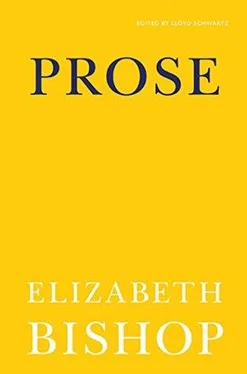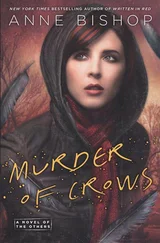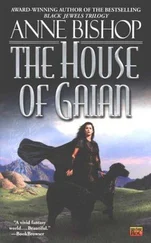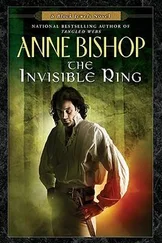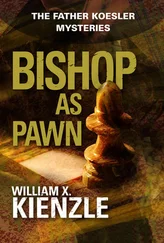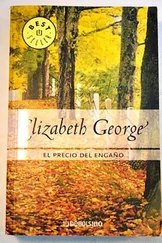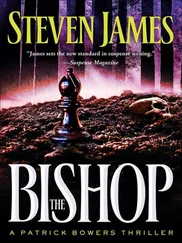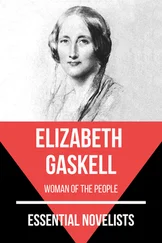(The frames these ancestor-children arrived in were a foot wide, painted and repainted with glittery, gritty gilt paint. They were meant to hang against dark wallpaper in a hair-cloth-and-mahogany northern parlor and brighten it up. I have taken the liberty of changing them to narrow, carefully dulled, gold ones, “modern.” Now the portraits are reduced to the scale suitable for hanging in apartments.)
Uncle Neddy stands on an imaginary dark red carpet, against a dun-colored wall. His right arm rests on the back of a small chair. This chair is a holy wonder; it must have been the painter’s “property” chair — at least I never saw anything like it in my grandmother’s house. It consists of two hard-looking maroon-colored pads, both hung with thick, foot-long, maroon fringes; the lower one makes the seat, the upper one, floating in the airless air, and on which Uncle Neddy’s arm rests, the back. Uncle Neddy wears a black suit, velveteen, I think; the jacket has pockets and is gathered to a yoke. He has a narrow white collar and white cuffs and a double black bow of what appears to be grosgrain ribbon is tied under the jacket collar. Perhaps his face is more oblivious than calm. Its not actually belonging to the suit or the chair gives it an extraneous look. It could almost have drifted in from another place, or another year, and settled into the painting. Plump (he was never in the slightest plump, that I can remember), his hair parted neatly on the left, his cheeks as pink as a girl’s, or a doll’s. He looks rather more like his sisters than like Uncle Neddy — the later versions of him, certainly. His tight trousers come to just below the knee and I can make out three ornamental buttons on each side. His weight rests on the left leg; his right leg is crossed in front of it and the toe of his right boot barely touches the other boot and the red carpet. The boots are very small, buttoned. In spite of his peaceful expression, they probably hurt him. I remember his telling me about the copper-toed boots he wore as a child, but these have no copper toes and must be his “good” boots. His body looks neatly stuffed. His eyes are a bright hazel and in the left one — right, to me — the painter has carefully placed a highlight of dry white paint, like a crumb. He never looked so clean and glossy, so peaceful and godly, so presentable, again — or certainly not as I remember him.
But of course he did have a streak of godliness somewhere, or else of a hypocrisy so common then, so unrecognized, that it fooled everyone including himself. How often did my grandmother tell me that as a small boy my Uncle Neddy had read the Bible, Old and New Testaments, straight through three times? Even as a child, I never quite believed this, but she was so utterly convinced that perhaps it really was true. It was the thing for children to do. Little Edward had also been a great text-memorizer and hymn-singer, and this much I did believe because when I knew him he often quoted texts, and not the well-known ones that everybody quoted, either; and he sang in the church choir. He also said grace before meals. Rather, he read grace. His memory for texts apparently didn’t go that far. He had a little black book, printed in black on yellowish paper, with “artistic” red initial letters at the top and middle of each page, that gave two graces for every day in the year. This he held just under the edge of the table, and with his head down read the grace for that day and meal to his family, in a small, muffled voice. The little book was so worn with use that the pages were loose. Occasionally a few would fall out onto the floor and have to be retrieved when grace was over, while my little cousin Billy (Uncle Neddy’s youngest child, a year or two younger than I was) and I, if I happened to be present, rolled our eyes at each other and giggled. My grandparents rather disapproved of their son for using a book. After all, my grandfather thriftily said the same grace every time, year in, year out, at all our regular meals. “Oh Lord,” it began, “we have reasons to thank Thee”—but this sounded like “raisins,” to me. (But then, at this time I also confused “as we forgive our debtors” with “taters,” a word I’d heard used humorously for “potatoes.”) However, if we had company to dinner or “tea,” my grandfather was perfectly capable of producing a longer, more grateful one, or even making up one of his own to suit the occasion.
Until age or drink had spoiled it, Uncle Neddy had a very nice baritone voice, and Sundays when he was well enough to go to church he appeared in the back row of the choir. On those days he wore a navy blue suit and a hard collar, a dark blue satin tie with a red stripe, and a stickpin with a small, dead diamond in it, much like the white highlight in his left eye that I am contemplating right now.
But I want to try to be chronological about this little boy who doesn’t look much like a little boy. His semidisembodied head seems too big for his body; and his body seems older, far less alive, than the round, healthy, painted face which is so very much in the present it seems to be taking an interest in it, even here, so very far away from where it saw such a very different world for so long.
The first dramatic episode of his life that I know about was when his foot got scalded. He told me the story more than once, usually as a warning to keep away from something hot. It concerned his boots, not these in the painting but his first pair of copper-toed boots, real little boots, no buttons or laces. Out of curiosity, he stood too near someone who was dipping boiling water out of the big boiler on the back of the kitchen stove and somehow a dipperful fell straight into a boot top. The boot was pulled off immediately, and then his sock. “And the skin came with it,” Uncle Neddy always said, proud and morbid, while an icicle suddenly probed the bottom of my stomach. The family doctor came, and for a long time poor Uncle Neddy couldn’t walk. His mother and sisters — he was the only son, the second child — all said he had been a very stoical boy; on that occasion he had only given one scream. Later on, he had performed prodigies of stoicism in respect to the Nova Scotian winter cold. He couldn’t endure being bundled up and would run out of the house and all the way to school, with the thermometer at ten, or twenty, below, without his overcoat. He would condescend to wear mittens and a muffler, but no more, and his ears had been frostbitten over and over again, and once one was frozen.
After these feats of endurance, his life, except for the Bible reading, is unknown to me for a long time. No — it was Uncle Neddy who dug all the wax off the face of my mother’s big wax doll from France, with his fingernails, and chewed it like chewing gum. The delicacy of the doll’s complexion depended on this wax; without it, she was red-faced and common. Uncle Neddy and my mother were playing upstairs; when my mother protested, he pushed her downstairs. Then when she pretended to faint and lay there at the foot of the stairs with her eyes shut, in great remorse he ran and got a quart dipper full of icy well water and threw it over her, crying out that he had killed his little sister.
And although she has been dead for over forty years, his little sister is here now, too, beside him. Her imaginary carpet is laid out geometrically in dark red, green, and blue, or is it supposed to be tiles? and her wall is darker than his. She leans on a fairly normal round table, draped in a long red tablecloth, and her left leg is crossed over her right one. She must be about nine. She wears a small bustle and a gold brooch, but her black hair is cut short all over, with a fringe over her eyes, and she looks almost more like a boy than he does.
The paintings are unsigned and undated, probably the work of an itinerant portrait painter. Perhaps he worked from tin-types, because in the family album the little girl’s dress appears again. Or did she have only the one dress, for dress-up? In the painting it is dark blue, white-sprigged, with the bustle and other additions purple, and two white frills making a sort of “bertha.” (In the tintype the French wax doll appears, too, seated on her lap, big and stiff, her feet sticking out in small white boots beneath her petticoats, showing fat legs in striped stockings. She stares composedly at the camera under a raffish blond wig, in need of combing. The tintype man has tinted the cheeks of both the doll and my mother a clear pink. Of course, this must have been before the doll had lost her waxen complexion under Uncle Neddy’s fingernails.)
Читать дальше
